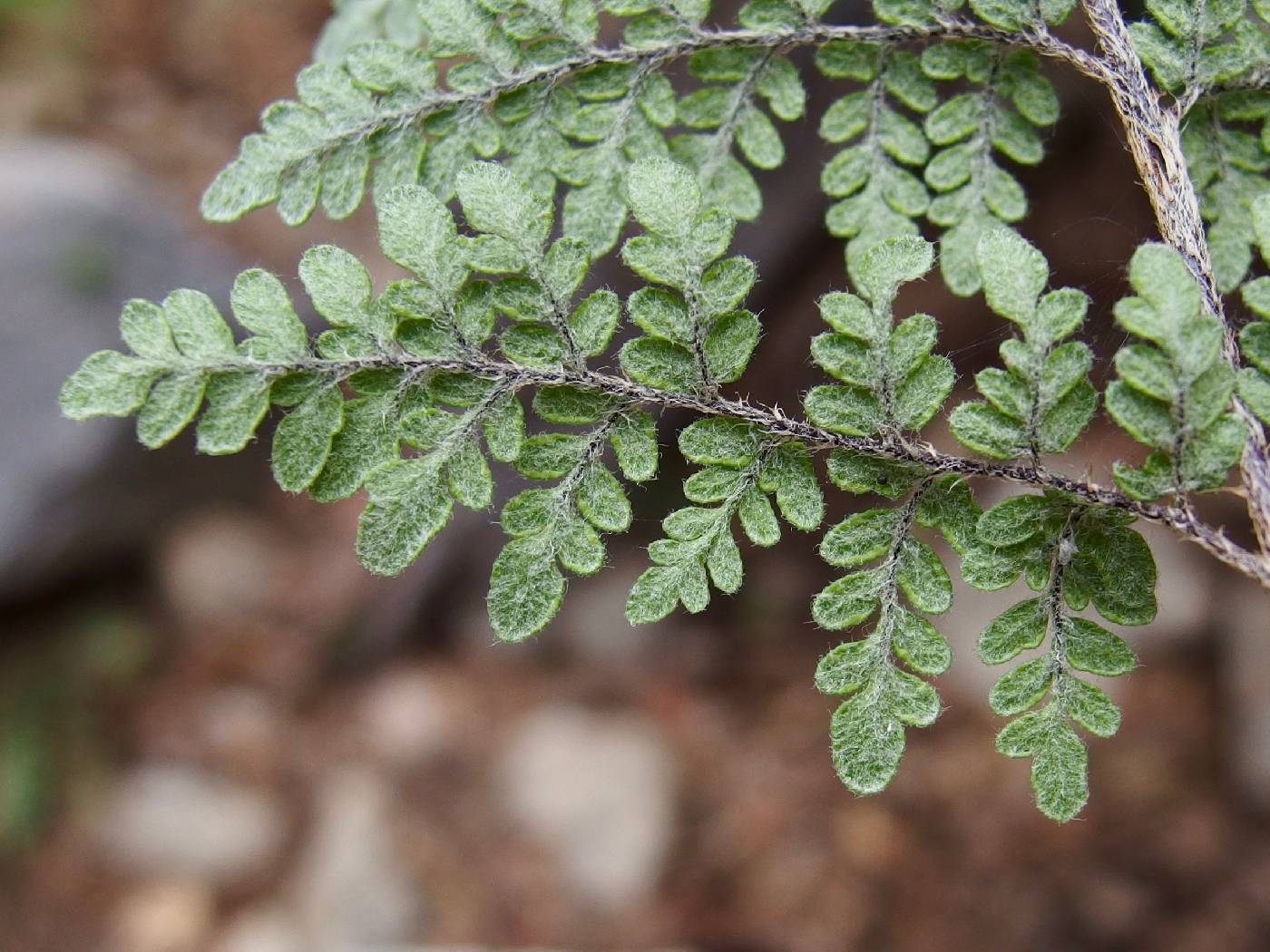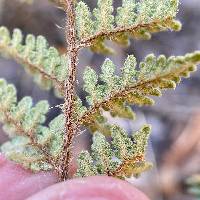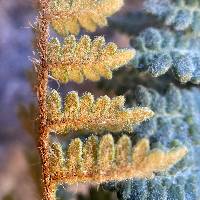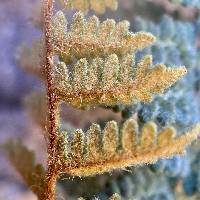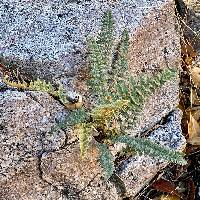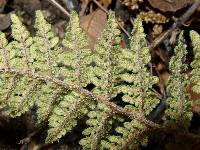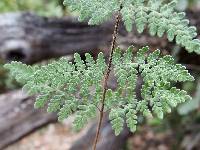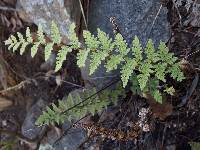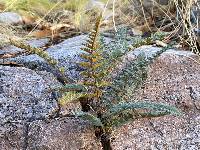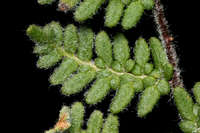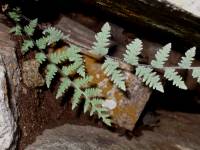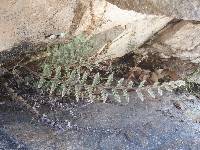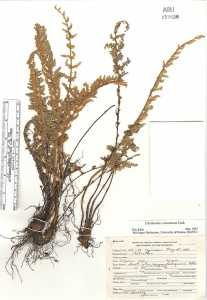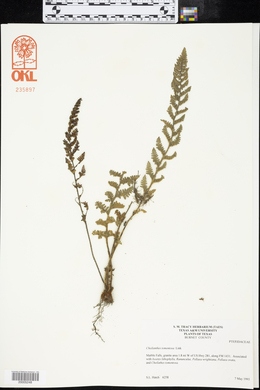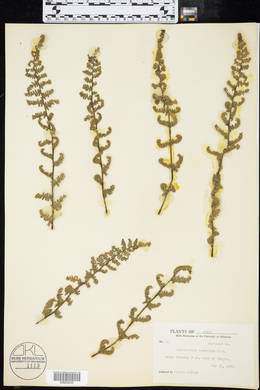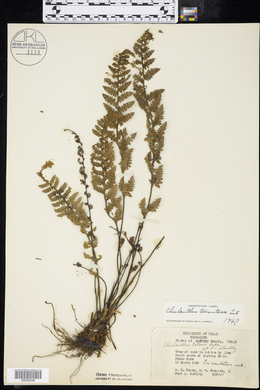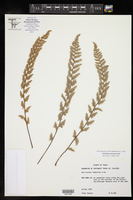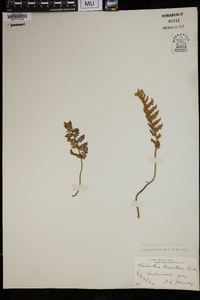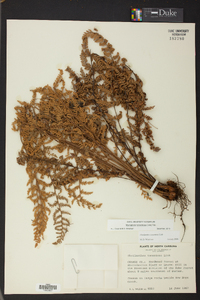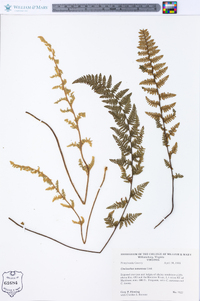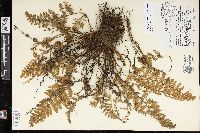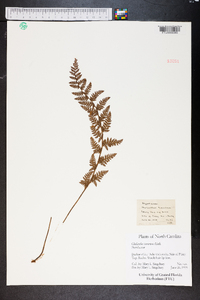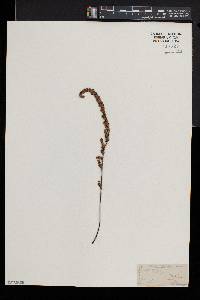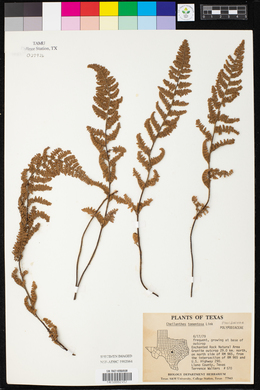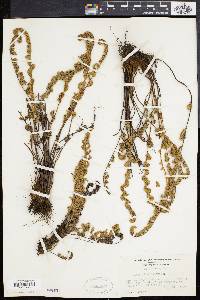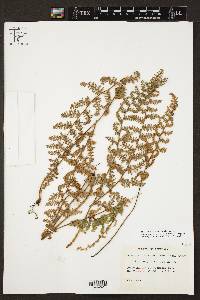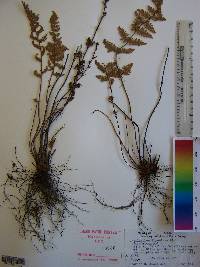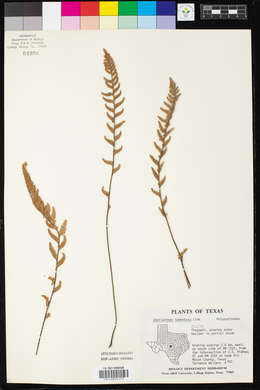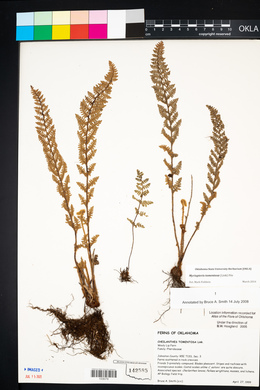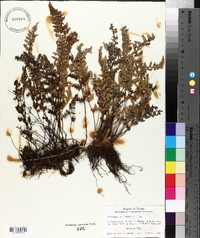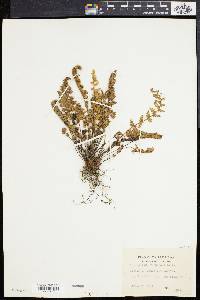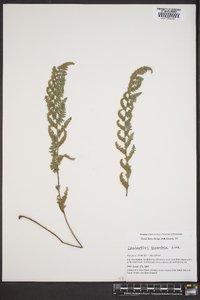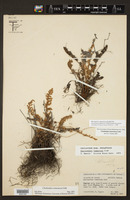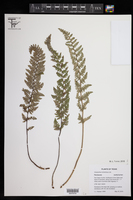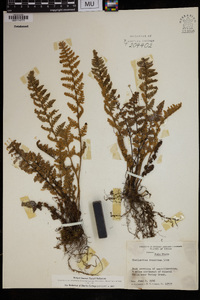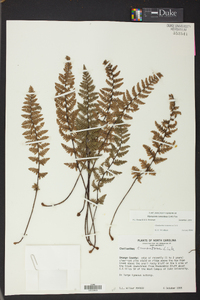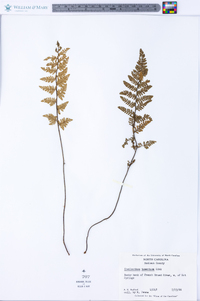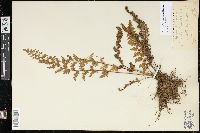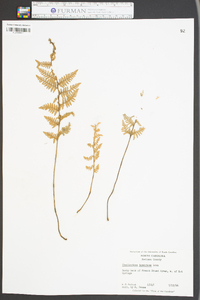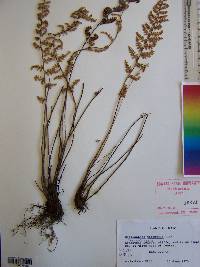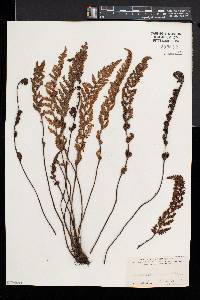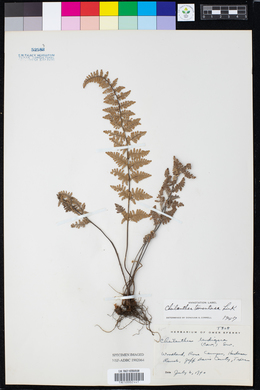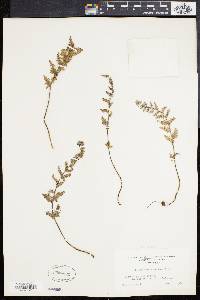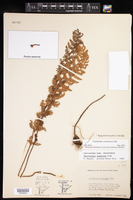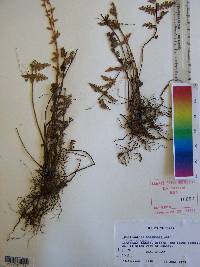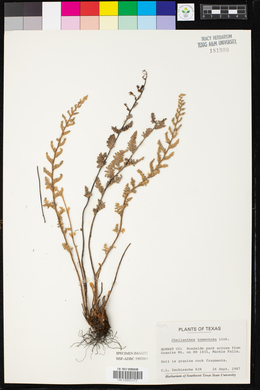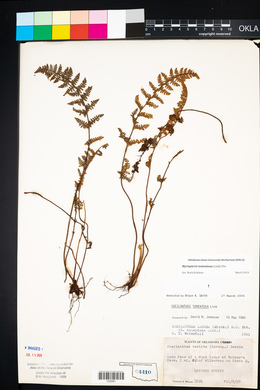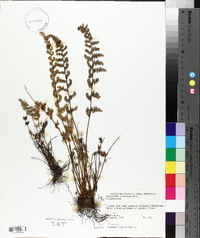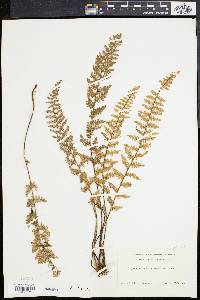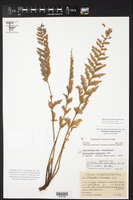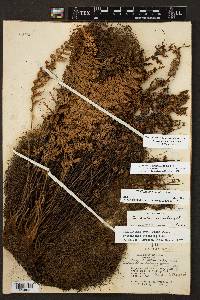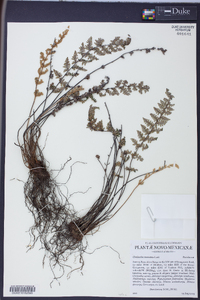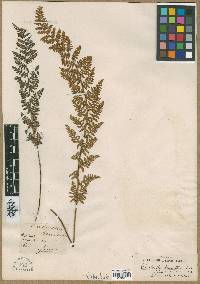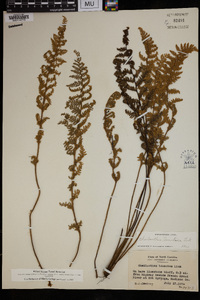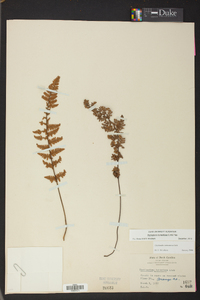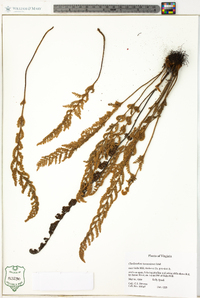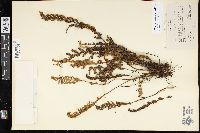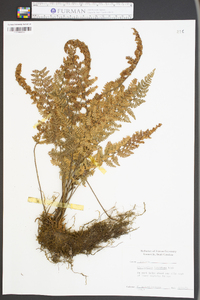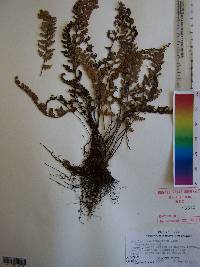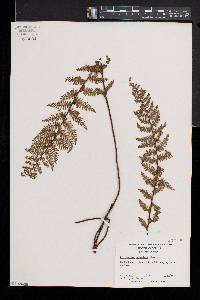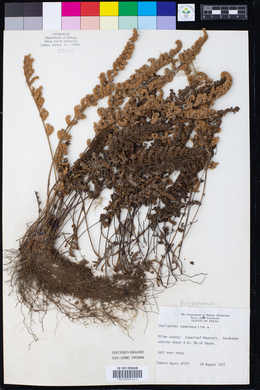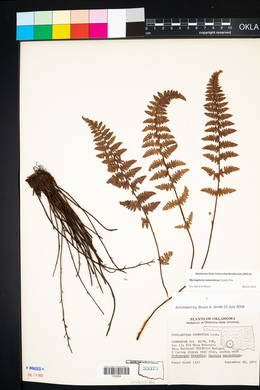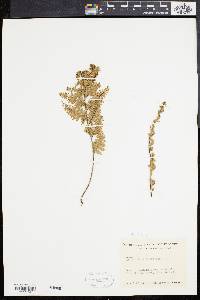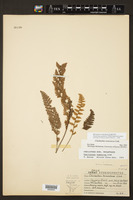Myriopteris tomentosa
|
|
|
|
Family: Pteridaceae
Woolly Lip Fern, more...woolly lipfern, woolly lipfern
[Cheilanthes bradburii Hook., moreCheilanthes tomentosa Link, Hemionitis bradburii (Hook.) Christenh.] |
Stems compact, usually 4--8 mm diam.; scales mostly bicolored, with broad, well-defined, dark, central stripe and narrow, light brown margins, linear-lanceolate, straight to slightly contorted, loosely appressed, persistent. Leaves clustered, 8--45 cm; vernation noncircinate. Petiole usually dark brown, rounded adaxially. Blade oblong-lanceolate, usually 4-pinnate at base, 1.5--8 cm wide; rachis rounded abaxially, with scattered linear scales and monomorphic pubescence. Pinnae not articulate, dark color of stalk continuing into pinna base, basal pair not conspicuously larger than adjacent pair, usually equilateral, appearing tomentose adaxially. Costae green adaxially for most of length; abaxial scales multiseriate, linear, truncate at base, inconspicuous, the largest 0.1--0.4 mm wide, loosely imbricate, not concealing ultimate segments, usually entire, not ciliate. Ultimate segments oval or rarely oblong, beadlike, the largest 1--2 mm, abaxially densely tomentose, adaxially pubescent with fine, unbranched hairs. False indusia marginal to obscurely inframarginal, somewhat differentiated, 0.05--0.25 mm wide. Sori ± continuous around segment margins. Sporangia containing 32 spores. n = 2 n = 90, apogamous. Sporulating summer--fall. Rocky slopes and ledges, on a variety of substrates including limestone and granite; 200--2400 m; Ala., Ariz., Ark., Ga., Kans., Mo., N.Mex., N.C., Okla., Pa., S.C., Tenn., Tex., Va., W.Va.; Mexico. Cheilanthes tomentosa is an apogamous triploid of unknown parentage. It is closely related to C . eatonii , but it is distinguished by having narrower, less prominent costal scales. Natural hybrids between these two species have been reported (D. S. Correll 1956), but such hybrids are unlikely because both species are apogamous in the supposed region of hybridization.
General: Clustered leaves 8-45 cm tall, from compact stems, 4-8 mm in diameter, bicolored scales, with broad dark, central stripe and narrow, light brown margins, linear lanceolate, loosely appressed and persistent, noncircinate vernation. Leaves: On dark brown petiole, rounded above, with blade oblong-lanceolate, usually 4-pinnate at base, 1.5-8 cm wide, rachis rounded below with scattered linear scales and monomorphic pubescence; pinnate not articulate, usually equilateral at base, appearing tomentose above; costae green for most of length, lower scales linear, truncate, loosely imbricate, not concealing ultimate segments, usually entire, not ciliate; ultimate segments oval or oblong, beadlike, largest 1-2 mm, densely tomentose below, pubescent with fine, unbranched hairs above. Sporangia: False indusia marginal to obscurely below the margin, sori continous around segment margins and almost hidden. Ecology: Found on rocky slopes and along ledges on a variety of substrates from 4,000-7,500 ft (1219-2286 m); sporulates summer-fall. Notes: Frequently confused with C. eatonii, differing in the scales on the rachis and abaxial surface of the pinnae are narrow and hairlike, rather than broader and more or less ovate; interestingly, C. eatonii is often more densely tomentose on the upper surface. Etymology: Cheilanthes is from Greek cheilos for lip and anthos for flower, while tomentosa means densely covered with matted wool or short hair. Sources: FNA 1993, Dittmer et al. 1954, Kearney and Peebles 1969 FNA 1993, Dittmer et al. 1954, Kearney and Peebles 1969 Common Name: woolly lipfern General: Clustered leaves 8-45 cm tall, from compact stems, 4-8 mm in diameter, bicolored scales, with broad dark, central stripe and narrow, light brown margins, linear lanceolate, loosely appressed and persistent, noncircinate vernation. Leaves: On dark brown petiole, rounded above, with blade oblong-lanceolate, usually 4-pinnate at base, 1.5-8 cm wide, rachis rounded below with scattered linear scales and monomorphic pubescence; pinnate not articulate, usually equilateral at base, appearing tomentose above; costae green for most of length, lower scales linear, truncate, loosely imbricate, not concealing ultimate segments, usually entire, not ciliate; ultimate segments oval or oblong, beadlike, largest 1-2 mm, densely tomentose below, pubescent with fine, unbranched hairs above. Sporangia: False indusia marginal to obscurely below the margin, sori continous around segment margins and almost hidden. Ecology: Found on rocky slopes and along ledges on a variety of substrates from 4,000-7,500 ft (1219-2286 m); sporulates summer-fall. Notes: Frequently confused with C. eatonii, differing in the scales on the rachis and abaxial surface of the pinnae are narrow and hairlike, rather than broader and more or less ovate; interestingly, C. eatonii is often more densely tomentose on the upper surface. Ethnobotany: Unknown Etymology: Cheilanthes is from Greek cheilos for lip and anthos for flower, while tomentosa means densely covered with matted wool or short hair. Synonyms: None Editor: SBuckley, 2010 Rhizome short, erect, multicipital, its scales linear, 5-6 mm, brown with a dark central band; lvs tufted, 15-40 cm, the 5-11 cm petiole evidently shorter than the blade, hirsute-lanuginose and with intermingled linear-subulate white scales to ca 0.1 mm wide; blade lance- linear or lanceolate, 1.5-4 cm wide, tripinnate, green and sparsely villous above, densely rusty-woolly beneath, tripinnate, the rachis woolly and with intermingled slender, hair-like scales like those of the petiole, but these scarcely or not at all extending to the costae and lower surface; pinnae 15-25 pairs, lance-ovate; pinnules 6-11 pairs; ultimate segments obovate or suborbicular, typically 1-2 times as long as wide, decurrent, the margins inrolled and with a pale, scarious edge; 2n=87 (triploid). Rock ledges in subacid soil; w. Va., W.Va., and Ky., s. and w. to Ga., Ark., Tex., and Mex.; reported from Pa. (C. lanosa sensu Fernald, misapplied) Gleason, Henry A. & Cronquist, Arthur J. 1991. Manual of vascular plants of northeastern United States and adjacent Canada. lxxv + 910 pp. ©The New York Botanical Garden. All rights reserved. Used by permission. |
|
|
|

